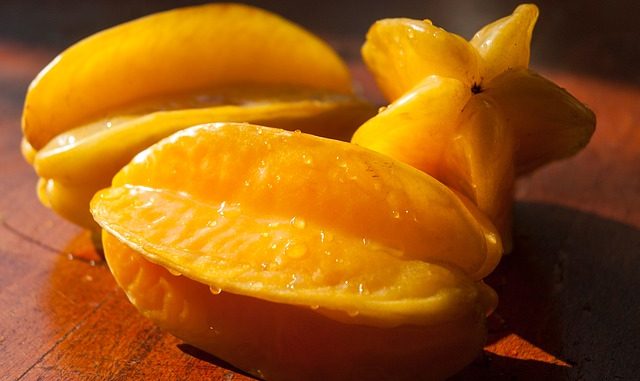
The starfruit has the scientific name Averrhoa carambola L. It is also called the carambola.
Cultivation
Flavour Compounds
Starfruit contains at least 200 different volatiles which make up a complex aroma profile. Starfruit falvour has been studied using a high-vacuum distillation liquid-liquid extraction technique.
Glycosides were isolated from extracts using Amberlite XAD-2 adsorbents. Most of the aglycones released by almond β‐glucosidase hydrolysis were carotenoid degradation products. These are all C13-norisoprenoid precursors. These included megastigma‐6,7‐diene‐3,5,9‐triol, an important precursor of the potent aroma compound β‐damascenone. Other aglycone compounds included these ionone derivatives: 4‐hydroxy‐β‐ionol, 3‐hydroxy‐β‐ionol, 4‐oxo‐β‐ionol, 3‐hydroxy‐β‐ionone, 3‐oxo‐α‐ionol, 3‐oxo‐retro‐α‐ionol (2 isomers), 3‐oxo‐4,5‐dihydro‐α‐ionol, 3‐oxo‐7,8‐dihydro‐α‐ionol (‘Blumenol C’), 3‐hydroxy‐β‐damascone, 3,5‐dihydroxy‐megastigma‐6,7‐diene‐9‐one (‘grasshopper ketone’), 3‐hydroxy‐5,6‐epoxy‐β‐ionone, 3‐hydroxy‐5,6‐epoxy‐β‐ionol, 3,4‐dihydro‐3‐hydroxyactinidol, vomifoliol (‘Blumenol A’), 4,5‐dihydrovomifoliol, and 7,8‐dihydrovomifoliol (‘Blumenol B’) (Herderich et al., 1992).
Only fresh fruit will show these compounds in any significant concentrations as they are easily destroyed during heat processing in juice production. It is a classic case of how carotenoids are good precursors of aroma.
Health Benefits
In addition to being delicious, carambola offers several potential health benefits. It is important to note that scientific research on the specific health benefits of carambola is limited, and the information provided here is based on general knowledge about the fruit and its nutritional composition.
- Rich in Vitamin C: Carambola is an excellent source of vitamin C, which is an important antioxidant that helps protect the body against free radicals. Vitamin C also plays a role in collagen synthesis, supports the immune system, and aids in iron absorption.
- Dietary Fiber: Carambola contains a good amount of dietary fiber, which can promote healthy digestion and prevent constipation. Adequate fiber intake is also associated with a reduced risk of chronic diseases such as heart disease and diabetes.
- Hydration: Carambola has a high water content, which can help keep the body hydrated. Proper hydration is important for overall health and supports various bodily functions.
- Antioxidant Activity: Carambola contains various antioxidants such as flavonoids, polyphenols, and vitamin C. These antioxidants help neutralize harmful free radicals, reduce oxidative stress, and protect the body’s cells from damage.
- Weight Management: Carambola is relatively low in calories and fat, making it a suitable choice for individuals who are watching their weight. Its high fiber content can also contribute to a feeling of fullness and aid in appetite control.
- Nutritional Content: Carambola is a good source of important vitamins and minerals such as potassium, magnesium, and vitamin A. These nutrients play various roles in the body, including supporting heart health, maintaining electrolyte balance, and promoting healthy vision.
It’s worth noting that while carambola has potential health benefits, individual results may vary. Additionally, if you have any specific health concerns or conditions, it’s always a good idea to consult with a healthcare professional or a registered dietitian before making significant changes to your diet.
References
Gunawardena, D. C., Jayasinghe, L., & Fujimoto, Y. (2015). Phytotoxic constituents of the fruits of Averrhoa carambola. Chemistry of Natural Compounds, 51(3), pp. 532-533
Herderich, M., Neubert, C., Winterhalter, P., Schreier, P., & Skouroumounis, G. K. (1992). Identification of C13‐norisoprenoid flavour precursors in starfruit (Averrhoa carambola L.). Flavour and Fragrance Journal, 7(4), pp. 179-185 (Article)
Warren, O., & Sargent, S. A. (2011). Carambola (Averrhoa carambola L.). In Postharvest Biology and Technology of Tropical and Subtropical Fruits (pp. 397-414e). Woodhead Publishing.
Winterhalter, P., Lutz, A., Herderich, M., & Schreier, P. (1995). Starfruit (Averrhoa carambola L.) Attractive Source for Carotenoid-Derived Flavor Compounds.
Winterhalter, P., & Schreier, P. (1995). The generation of norisoprenoid volatiles in starfruit (Averrhoa carambola L.): a review. Food Reviews International, 11(2), pp. 237-254.
Leave a Reply